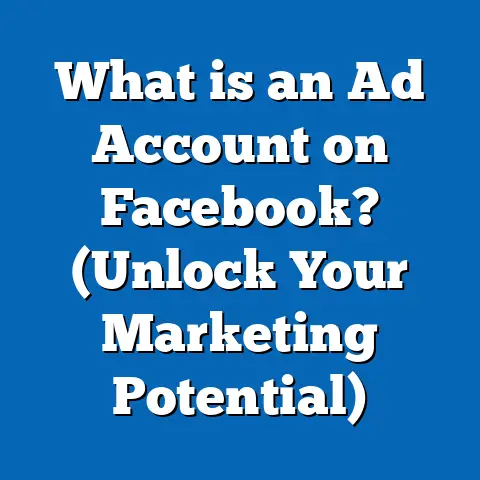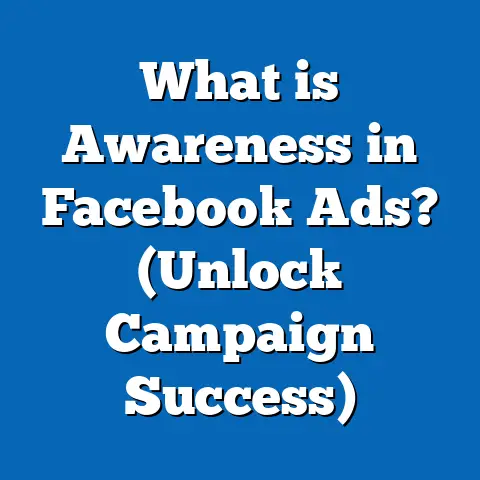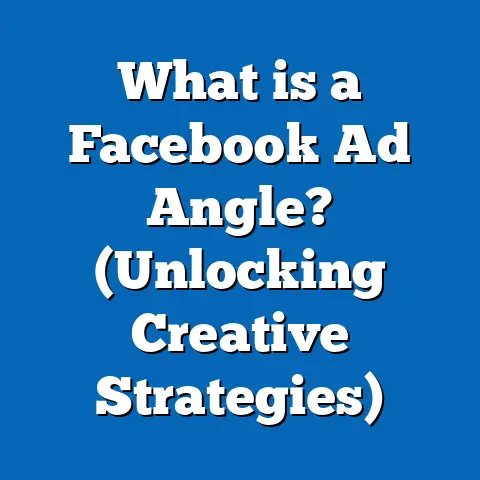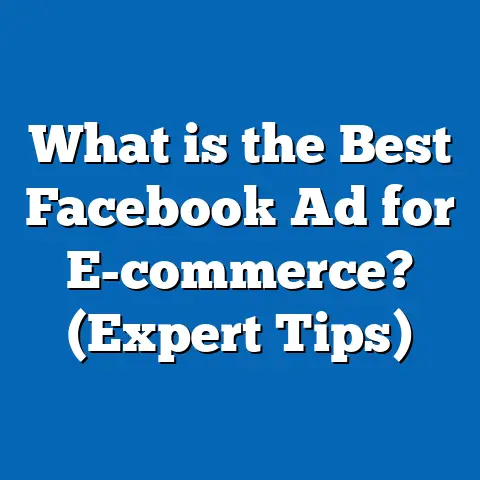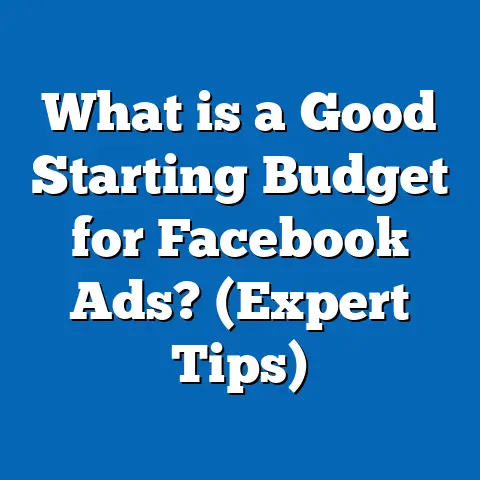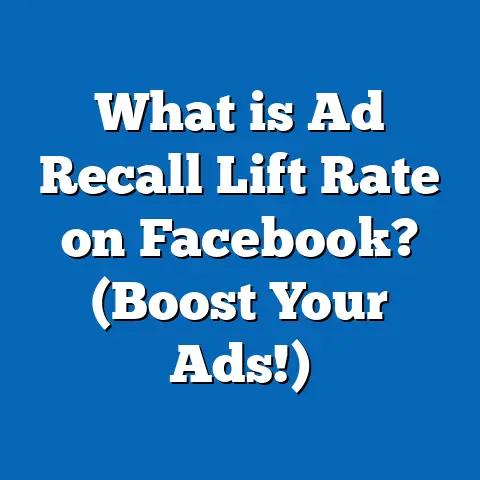What is Ad Copy in Facebook Ads? (Unlocking Engagement Secrets)
What is Ad Copy in Facebook Ads? (Unlocking Engagement Secrets)
Introduction: Seasonal Surge in Digital Advertising
As the holiday season approaches, businesses of all sizes intensify their marketing efforts to capture the heightened consumer attention. Social media feeds become crowded with festive promotions, gift ideas, and special deals. Amid this saturation, what truly determines whether your ad stands out or gets lost in the noise? The answer lies not just in eye-catching visuals but critically in ad copy — the carefully crafted words that connect with your audience’s emotions, needs, and motivations.
Facebook advertising offers unparalleled reach with over 2.9 billion monthly active users worldwide as of early 2024. But with billions of ads competing for attention, only those with compelling ad copy break through to drive clicks, leads, and sales. Whether you’re a seasoned marketer or a business owner new to Facebook ads, mastering ad copy is essential for unlocking engagement secrets that convert browsers into loyal customers.
Understanding Ad Copy in Facebook Ads
What is Ad Copy?
Ad copy refers to the text elements of your Facebook ad designed to communicate your message clearly and motivate user action. Unlike organic posts, Facebook ads focus on prompting specific behaviors such as clicking a link, installing an app, making a purchase, or signing up for services.
Key parts of ad copy include:
- Headline: The main text shown prominently; it grabs initial attention.
- Primary Text: The longer block of text providing details or storytelling.
- Call-to-Action (CTA): A prompt telling viewers what action to take next.
- Link Description: Supplementary text that supports the headline.
- Text Overlay: Text placed on images/videos for added emphasis.
Together, these elements form a persuasive message that aligns with the ad’s visual components to maximize impact.
Why Ad Copy Matters in Facebook Advertising
Facebook ads compete in a highly dynamic environment where users scroll rapidly through content. Your ad copy must stop users mid-scroll and compel them to engage. Here’s why it matters:
- First impression: Words often form the first direct connection between your brand and potential customers.
- Clarifies value: Good copy explains what’s being offered and why it matters.
- Builds trust: Authentic, transparent messaging builds credibility.
- Drives action: Effective CTAs convert interest into measurable outcomes.
Without strong ad copy, even the best visuals or offers may fail to deliver results.
Real-World Impact: Stats on Ad Copy Effectiveness
- A WordStream study found that ads with clear and focused ad copy had up to 27% higher click-through rates than those with vague or generic messaging.
- Facebook reports that ads using personalized copy tailored to specific audience segments experienced a 35% boost in engagement.
- HubSpot’s research shows emotional appeal in ad copy can increase CTR by 23% compared to fact-only messaging.
The Anatomy of Effective Facebook Ad Copy
Key Components Explained
Headline
The headline is the hook that grabs attention instantly. On Facebook, headlines appear below or near the image/video and are usually bolded or larger font size.
Tips for headlines:
- Use strong action verbs (“Get,” “Discover,” “Save”).
- Highlight benefits or unique selling points.
- Keep it concise—ideally between 5 to 8 words.
- Include numbers or percentages if relevant (e.g., “Save 30% Today”).
Primary Text
Best practices:
- Write conversationally—speak directly to your audience.
- Address pain points or desires.
- Use short paragraphs or bullet points for readability.
- Keep it between 90 and 150 characters for optimal engagement based on AdEspresso data.
Call-to-Action (CTA)
Your CTA tells users exactly what you want them to do next.
Common CTAs include:
- “Shop Now”
- “Sign Up”
- “Learn More”
- “Download”
- “Get Offer”
CTAs should be clear, direct, and create urgency when possible.
Link Description
This optional text appears under the headline to provide extra detail. It can reinforce your message or clarify what users get after clicking.
Text Overlay on Visuals
Text on images or videos can emphasize key points but should remain minimal to avoid clutter and adhere to Facebook’s guidelines (historically limiting text overlay to 20% of image area).
Emotional vs. Rational Appeals
HubSpot’s comparison between emotional and rational ad copy revealed:
- Emotional appeals generated a 23% higher CTR.
- Rational appeals tend to work better in B2B settings with detailed product info but still benefit from emotional hooks.
Personalized Messaging Increases Conversion Rates
Facebook’s dynamic creative ads use AI to serve different versions of copy based on user data:
- Personalized ads increased conversions by 15-20%.
- Ads tailored by age, gender, interests outperformed generic messaging significantly.
Deep Dive: Writing Ad Copy for Different Campaign Objectives
Brand Awareness Campaigns
Goal: Introduce your brand and create a memorable impression.
Copy Tips:
- Focus on storytelling and emotional connection rather than direct sales.
- Use simple language that highlights brand values.
- Example: “Meet [Brand], where style meets sustainability. Join our journey towards eco-friendly fashion.”
Lead Generation Campaigns
Goal: Capture user information through sign-ups or downloads.
Copy Tips:
- Highlight benefits of signing up (free resources, exclusive info).
- Create urgency (“Limited spots available”).
- Example: “Download our free guide to mastering digital marketing in 2024—start growing your business today!”
Conversion Campaigns (Sales)
Goal: Drive immediate purchases or actions.
Copy Tips:
- Use strong CTAs and emphasize discounts or limited offers.
- Include testimonials or social proof.
- Example: “Save 30% on our best-selling winter jackets! Shop now before they’re gone.”
Practical Examples and Case Studies
Case Study: Seasonal E-commerce Campaign
A fashion retailer ran two versions of holiday sale ads:
Version A (Discount-focused):
- Headline: “Holiday Sale: Up to 50% Off!”
- Text: “Shop cozy sweaters and festive accessories today. Hurry—sale ends soon!”
- CTA: “Shop Now”
Version B (Story-driven):
- Headline: “Make This Holiday Cozy & Stylish”
- Text: “Wrap yourself in warmth and memories with our exclusive holiday collection.”
- CTA: “Shop Now”
Results:
Version B generated:
- 32% higher CTR
- 18% higher conversion rate
- Lower cost per acquisition by 12%
Case Study: B2B SaaS Lead Generation
A software company tested two copies for lead generation:
Version A (Feature-focused):
- Headline: “All-in-One Marketing Platform”
- Text: “Manage campaigns, track analytics, and grow leads—all in one place.”
- CTA: “Start Free Trial”
Version B (Benefit-focused):
- Headline: “Grow Leads by 40% Faster”
- Text: “Join marketers who boost ROI with our smart automation tools.”
- CTA: “Get Started”
Results:
Version B had a:
- 25% higher sign-up rate
- More engaged leads (measured by demo requests)
Technical Concepts Explained Simply
Click-Through Rate (CTR)
CTR measures how well your ad copy motivates users to click. It’s calculated as: CTR=Number of ClicksNumber of Impressions×100%\text{CTR} = \frac{\text{Number of Clicks}}{\text{Number of Impressions}} \times 100\%
A higher CTR means your copy resonates well with your audience.
Conversion Rate
Conversion rate measures how many users complete a desired action after clicking an ad—such as buying a product or filling out a form. Conversion Rate=ConversionsClicks×100%\text{Conversion Rate} = \frac{\text{Conversions}}{\text{Clicks}} \times 100\%
Effective ad copy can improve both CTR and conversion rate by setting clear expectations and motivating follow-through.
A/B Testing Explained
A/B testing involves creating two (or more) versions of an ad differing only in one element—such as headline or CTA—to see which performs better. This data-driven approach helps optimize ad copy over time.
Advanced Strategies for Writing Facebook Ad Copy
Psychological Triggers in Copywriting
Using psychology can dramatically improve engagement:
- Social Proof: Mention satisfied customers or reviews (“Join 10,000 happy clients”).
- Scarcity & Urgency: Words like “Limited stock” or “Offer ends today” push quick decisions.
- Reciprocity: Offer freebies upfront (“Download our free ebook”).
- Authority: Highlight endorsements by experts or awards.
- Consistency: Encourage small commitments leading up to bigger actions.
Leveraging Facebook’s Latest Features & AI Tools
Facebook constantly updates its ad platform with features impacting copywriting:
- Dynamic Creative Ads: Automatically generate multiple text variants tailored per user profile.
- AI-Powered Suggestions: Facebook Ads Manager now offers AI-generated headline and primary text suggestions based on historical data.
- Emoji Use: Strategic emojis can make copy more relatable but should be used sparingly to maintain professionalism.
- Video Captions: Since many watch videos muted, including captions ensures your message is delivered without sound.
Comparison: Facebook Ad Copy vs. Other Platforms
| Feature | Facebook Ads | Google Search Ads | Instagram Ads |
|---|---|---|---|
| Copy Length | Moderate length; allows storytelling | Very limited characters | Similar to Facebook; visuals-focused |
| Emotional Appeal | High emphasis | Low; focused on search intent | High; lifestyle & emotion-driven |
| Audience Targeting | Highly granular demographic & interest-based | Keyword intent targeting | Interest & behaviors like Facebook |
| Visual Integration | Strong integration with images/videos | Text-only | Highly visual |
| CTA Options | Multiple CTA buttons | Limited CTAs | Multiple CTAs |
Facebook’s flexibility allows for detailed storytelling and emotional connection via ad copy unlike Google’s keyword-driven text ads.
Writing Ad Copy for Different Industries
Retail & E-commerce
Focus on promotions, benefits, urgency, and seasonal relevance.
Example:
“Freshen up your summer wardrobe! Shop now for exclusive styles + free shipping.”
SaaS & Technology
Emphasize problem-solving, ROI benefits, and easy onboarding.
Example:
“Boost productivity by 30% with our intuitive project management tool. Try free for 14 days.”
Health & Wellness
Use empathetic language focusing on transformation and trust.
Example:
“Feel energized every day with our natural supplements. Join thousands who made the switch.”
Travel & Hospitality
Highlight experiences, exclusivity, and urgency around booking deadlines.
Example:
“Escape winter blues—book your tropical getaway today & save 25%!”
Common Mistakes to Avoid in Facebook Ad Copy
- Overloading Text: Too much information overwhelms users.
- Vague Messaging: Be specific about benefits; avoid generic statements.
- Ignoring Audience Segmentation: One-size-fits-all rarely works.
- Weak CTAs: Don’t leave users guessing what to do next.
- Neglecting Mobile Users: Most Facebook users access via mobile; keep copy concise and easy to scan.
- Ignoring Data: Not using analytics to refine copy wastes budget.
Tools and Resources for Crafting Better Facebook Ad Copy
- Facebook Ads Manager Insights: Analyze ad performance data including CTR and conversion rates.
- AdEspresso’s Ad Examples Library: Explore top-performing ads across industries.
- Grammarly & Hemingway Editor: Improve clarity and readability.
- Canva Text Tools: Helps design visual overlays that complement copy.
- Google Trends & BuzzSumo: Find trending keywords/topics relevant to your audience.
- A/B Testing Platforms: Use tools like Optimizely or SplitMetrics alongside Facebook’s native testing features.
How to Test and Optimize Your Facebook Ad Copy Over Time
- Set clear KPIs (Click-through rate, Conversion rate).
- Create multiple versions varying one element at a time (headline, CTA).
- Run tests for sufficient duration/sample size (at least several days or thousands of impressions).
- Analyze results focusing on statistical significance.
- Apply learnings—keep winning versions, iterate on underperformers.
- Monitor seasonality effects; adapt copy accordingly.
Optimization is an ongoing process requiring patience but rewarding with improved ROI.
The Future of Facebook Ad Copywriting
With AI-driven personalization growing rapidly, expect more automated but still highly relevant ad copy tailored individually based on behavior patterns. Marketers who combine AI tools with human creativity will lead the pack.
Voice search integration may also influence shorter conversational ad copies adapted for voice assistants connected through social media platforms.
Staying informed about platform updates ensures your messaging keeps pace with evolving user expectations and technology shifts.
Summary & Next Steps
Key Takeaways
- Ad copy is critical in grabbing attention and driving action in Facebook ads.
- Effective copy balances clarity, relevance, urgency, emotional appeal, and strong CTAs.
- Data shows shorter primary text (90–150 characters) performs best but always test variations.
- Emotional storytelling often outperforms dry product descriptions.
- Personalization through dynamic creative ads boosts engagement significantly.
- Regular A/B testing is essential for continuous improvement.
- Understand your campaign objectives to tailor copy appropriately.
- Leverage latest platform features like AI suggestions and video captions.
- Avoid common pitfalls such as overloaded text or weak CTAs.
Next Steps for Marketers & Business Owners
- Audit your current Facebook ad copy using these guidelines.
- Develop new versions using emotional hooks and clear CTAs.
- Implement A/B testing systematically for ongoing optimization.
- Stay updated on Facebook Ads platform changes and industry trends.
- Consider professional copywriting help if needed for complex campaigns.
Mastering Facebook ad copywriting unlocks engagement secrets that amplify brand awareness, conversions, and long-term customer loyalty—especially during high-stakes seasons when competition peaks.

